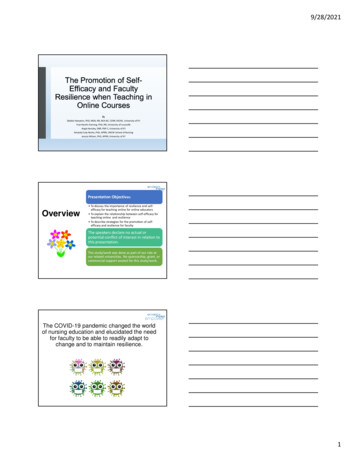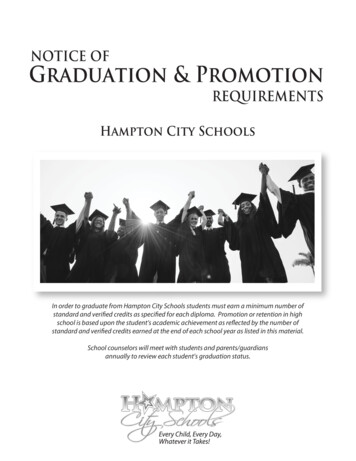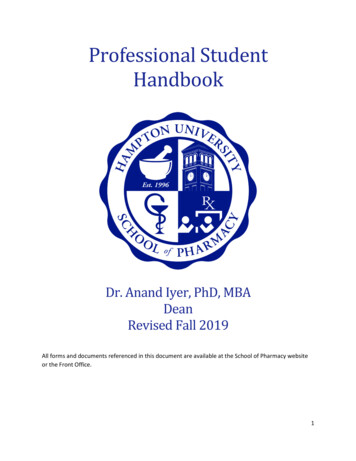
Transcription
9/28/2021ByDebbie Hampton, PhD, MSN, RN, NEA-BC, CENP, FACHE, University of KYFran Hardin-Fanning, PhD, RN, University of LouisvilleAngie Hensley, DNP, FNP-C, University of KYAmanda Culp-Roche, PhD, APRN, UNCW School of NursingJessica Wilson, PhD, APRN, University of KYPresentation Objectives:Overview To discuss the importance of resilience and selfefficacy for teaching online for online educators To explain the relationship between self-efficacy forteaching online and resilience To describe strategies for the promotion of selfefficacy and resilience for facultyThe speakers declare no actual orpotential conflict of interest in relation tothis presentation.This study/work was done as part of our role atour related universities. No sponsorship, grant, orcommercial support existed for this study/work.The COVID-19 pandemic changed the worldof nursing education and elucidated the needfor faculty to be able to readily adapt tochange and to maintain resilience.1
9/28/2021Introduction/Background Self-efficacy: Cognitive characteristic associated withpersistence and motivation in overcoming challenges Perceived self-efficacy represents the confidence toachieve success (Bandura, 1977 & 1995) Self-efficacy in online teaching reflects a belief in one’sability to manage personal behaviors and cognitiveprocesses for instructional effectiveness Is also an indicator of the teacher’s belief that he or she can makea difference in student learning outcomes in the course Our personal assessment of our ability to teach, andour confidence to overcome barriers represents ourself-efficacy for new teaching styles (Lassiter, 2020)Introduction/Background (c) Student success and learning have been shown tocorrelate with teacher self-efficacy (Corry & Stell,2018) Positive correlations demonstrated between teacher’sself-efficacy and various faculty and study instructionaloutcomes teacher well-being, work-satisfaction, commitment,effectiveness student engagement, motivation, achievement, and self-efficacy(Horvitz et al, 2015; Mok & Moore, 2019)Introduction/Background (c) Resilience: Ability to recover from adversity,overcome challenges, remain in a productivestate, and maintain a positive attitude (APA, 2017). Increased resilience is correlated with bothimproved physical and mental health (Asensio-Matinezet al., 2019). Resilience is a dynamic process that can change overtime and is enhanced by successful responses toadversity (Davidson, 2018; Richards et al., 2016).2
9/28/2021Introduction/Background (c) Multiple factors contribute to resilience including having strong supportive relationships, establishing realistic plans and being able toaccomplish them, communicating effectively, managing feelings and impulses, and maintaining self-confidence and a positiveview of one’s abilities (APA, 2017).The pandemichas given us aview of what“resilience in theface of adversitylooks like” (Lipson &Glickman, 2020).Methods Descriptive, cross-sectional IRB approved study Participants: Faculty who taught in Traditional BSN,RN to BSN, MSN, DNP, or PhD nursing programs Setting: Colleges of Nursing (10 universities) overseveral states (Central, Southern, Midwestern, andWestern regions) Procedures: Emailed invitation to participate in the study Link to survey situated in REDCap Implied consent3
9/28/2021Methods (c) Measures Self-efficacy for online teaching: Michigan NurseEducators Sense of Efficacy for Online Teaching instrument(MNESEOT)(32-items) Constructs within this scale include efficacy in relation to student engagement instructional strategies classroom management, and use of computers (Robina, 2008; Robina & Anderson, 2010). Resilience: 10 item Connor-Davidson resilience scale(CD-RISC 10) One construct focused around assessing how well a personcan endure difficult experiences and recover/bounce back(Campbell-Sills & Stein, 2007)Results: Total Sample (n 84)VariablePotential RangeAgeMean; range or %51.2; 29-70GenderMale11; 13.1%Female73; 86.9%RaceWhite75; 90.4%Other8; 9.6%ProgramUndergraduate only36; 42.9%Graduate only27; 32.1%Both graduate and UG21Total years teaching11; 0-36Prior online teaching (Yes)54(64.3%)Resilience (0-4 scale)10-4032.65Self-efficacy for teaching online32-160126.2Results (c) The highest subscale mean score on the MNESEOTinstrument (range 1–5) was online teacher self-efficacyrelated to computer skills (M 4.1), followed by classroommanagement (M 4.0), instructional strategies (M 3.9),and student engagement (M 3.7) Adjusting for age, sex, race, teaching program, years ofteaching experience, and institutional support, those withprior online teaching experience scored an average of 16.5points higher than those without prior online teachingexperience (p .001) Only years of on-line teaching significantly predicted selfefficacy.4
9/28/2021Regression Analysis withAdditional Data (N 148)Self-efficacy for teaching online was asignificant predictor of resilience(Coefficient 1.55, t(147) 8.78, p .0001)A one-unit increase in self-efficacy forteaching online is associated with a 1.6 pointincrease in resilience.Discussion SE for teaching online was relatively high (about the75% level) Faculty (overall mean) had a slightly above averagelevel of resilience (32.6). CD-RISC-10 general population scores average 32, withquartiles being 0 to 29, 30-32, 33-36, and 37-40 (Davidson,2018). Faculty resilience scores were similar to thosereported in studies prior to the COVID-19 pandemic. Resilience scores averaged 33 for faculty who taught inundergraduate and/or graduate online courses in sixcolleges of nursing (Wilson et al., 2021) Resilience averaged 32 for a study conducted near thebeginning of the pandemic at a school of nursing in onestate and its three satellite campuses (Keener et al, 2020).Discussion (c) As self-efficacy increases so does resilience Resilience was significantly correlated with alldimensions of SE for teaching online Results of this study illustrated the importance offacilitating faculty self-efficacy for teaching online5
9/28/2021Limitations Unsure of what % of faculty responded for somecolleges of nursing Response rate low Unsure who surveys were emailed to at eachsetting/site since relied on collaborating studypersonnel to send out surveysImplication for Academia High self-efficacy is associated with teaching satisfactionand higher emotional intelligence Teachers with high levels of SE have more resilience in thework environment, are more likely to stay, and are morewilling to try new innovative teaching methods And teachers with higher levels of SE may foster higher levels ofstudent engagement, satisfaction, and learning outcomes Strength of efficacy also leads to behavior change The higher one’s self-efficacy, the more likely people are to persistin their efforts to succeed; thus, The higher the level of perceived self-efficacy, the greater theperformance accomplishmentsImplication for Academia (c) Faculty resilience can mitigate the negative consequences ofworkplace stressors (Richard et al, 2016). Higher levels of resilience help faculty assimilate variousprotective factors, such as resources, attributes, and skills tomitigate stress and deal with challenges. Resilience and self-efficacy have a reciprocal relationship foreducators.6
9/28/2021Strategies to Build Personal Self-Efficacy(Lassiter, 2020)4 major sources for building confidence to performand persevere at a task (Bandura, 1982) Performance attainments or mastery: Small changescan lead to big victories With each small success you master a skill/task that buildsconfidence, leading to eventual competence and confidence withusing a variety of technology-based teaching methods. Vicarious experiences: Build confidence to try newthings by learning from others and seeing themsucceed Verbal persuasion: Convince people they have theability to accomplish tasks Network, talk to colleagues, share stories Emotional arousal: Practice self-care to remain physicallyand emotionally healthy, which will help increase optimismand positivity about our own teaching experiences4 Ways To Improve and Increase Self-Efficacy(positivepsychology.com)Best Frame of Mind for LearningThere are various zones of learning orpersonal achievement (Ryan and Markova, 2006) Comfort—Person feels comfortable and is notworried or fearful; no challenges to accentuate theneed for learning Stretch—Feels comfortable and safe and able toopen mind to new learning Panic –Overwhelmed, stressed, frightened;energy spent on managing fear7
9/28/2021Best Frame of Mind for Learning(c) Stay in the stretch zone(more willing to takechances and are moreresilient) How to stay in the right zone? Set goals Do things you like to do. Try new things and facechallenges. Accept failures andcriticisms positively. Approach goals slowly anddo not over-stress c.jpgIncreasing Self-efficacy and thusResilience Strategies for increasing SE and thus resilience include: assigning mentors for newer faculty to help them manage theirworkload providing professional development opportunities specific toonline teaching (self-development) education, education, education Gaining knowledge and skill heighten interest and sense ofefficacy role modeling (admire, follow, and desire to emulate) developing/evaluating methods of enhancing resilience in nursingfaculty Mindfulness interventions (Goldhagen et al, 2015) Remain positive ( emotions) (O’Grady, 2021)Engage in completely absorbing activities (O’Grady, 2021)Establish professional colleague relationships (O’Grady, 2021)Participate in activities that are meaningful for you (O’Grady, 2021)Achievement (mastery over a skill as noted above) (O’Grady, 2021)Publications Culp-Roche, A., Hardin-Fanning, F., Tartavoulle, T., Hampton, D., Hensley, A.,Wilson, J.L., & Wiggins, A.T (July 2021) Perception of online teacher self-efficacy:A multi-state study of nursing faculty pivoting courses during COVID 19. NurseEducation Today, 106, https://doi.org/10.1016/j.nedt.2021.105064. Wilson, J., Hensley, A., Culp-Roche, A., Hampton, D., Hardin-Fanning, F., &Wiggins, A. (June 2021). Transitioning to teaching online during the COVID-19pandemic. Sage Open Nursing, https://doi.org/10.1177/23779608211026137. Hampton, D., Hardin-Fanning, F., Hensley, A., Culp-Roche, A., Wilson, J., &Thaxton-Wiggins, A. (In Press). Nursing faculty resilience during a time ofdisruption and change. Nursing Education Perspectives.8
9/28/2021ReferencesAli N, Ali O, Jones J. (2017). High level of emotional intelligence is related to high level of online teaching self-efficacy among academicnurse educators. Int J Higher Educ., 6(5), 122-130.American Psychological Association. (2017). The road to sensio-Martínez, Á. et al (2019). Relation of the psychological constructs of resilience, mindfulness, and self-compassion on theperception of physical and mental health. Psychology Research and Behavior Management, 12, 1155.Bandura A. (1977). Self-efficacy: Toward a unifying theory of behavioral change. Psychol Rev. 84(2):191-215.Bandura A. (1982). Self-efficacy mechanism in human agency. American Psychology, 97)2), 122-147.Bandura A. (1986). The explanatory and predictive scope of self-efficacy theory. J Soc Clin Psychol. 4(3):359-373.Bandura A. (1995). Self-efficacy in changing societies. New York: Cambridge University Press.Bray-Clark N, Bates R. (2003). Self-efficacy beliefs and teacher effectiveness: Implications for professional development. Prof Edu. 003;6(1):13-22.Campbell-Sills, L. & Stein, M. B. (2007). Psychometric analysis and refinement of the Connor–Davidson resilience scale (CD-RISC):Validation of a 10-item measure of resilience. Journal of Traumatic Stress: Official Publication of The International Society for TraumaticStress Studies, 20(6), 1019-1028.Corry M, Stella J. (2018). Teacher self-efficacy in online education: A review of the literature. Res Learn Technol. 26.Davison, JRT. (2018). Connor-Davidson Resilience Scale. SC%20Manual%2008-1918.pdfGoldhagen BE, Kingsolver K, Stinnett SS, et al. (2015). Stress and burnout in residents: Impact of mindfulness-based resilience training.Adv Med Educ Pract., 6, 525– 532.Horvitz BS, Beach AL, Anderson ML, & Xia J. (2015). Examination of faculty self-efficacy related to online teaching. Innov High Educ.40(4), 305-316.ReferencesKeener, T. A., Hall, K., Wang, K., Hulsey, T., & Piamjariyakul, U. (2020). Relationship of Quality of Life, Resilience, and Associated FactorsAmong Nursing Faculty During COVID-19. Nurse Educator, 46(1), 17.Lassiter, J. (2020). Building self-efficacy: How to feel confident in your online feel-confident-in-your-onlineteaching/#: :text 0Confident%2Lipson, A., & Glickman, A. (2020). What Are We Learning about Academic Resilience? Association of American Colleges &Universities (aacu.org)Mok MC, Moore PJ. (2019). Teacher and self-efficacy. Edu Psychol. 39(1, 1-3.O’Grady, E. T. (2021). Self-leadership for NP’s in complex times. The Journal for Nurse Practitioners.Richards, K. A. R., Levesque-Bristol, C., Templin, T. J., & Graber, K. C. (2016). The impact of resilience on role stressors and burnout inelementary and secondary teachers. Social Psychology of Education, 19(3), 511-536.Robinia KA. (2008). Online teaching self-efficacy of nurse faculty teaching in public, accredited nursing programs in the state ofMichigan. Western Michigan content.cgi?referer https://www.google.com/&httpsredir 1&article 1813&context dissertationsRobinia KA, Anderson ML. (2010). Online teaching efficacy of nurse faculty. J Prof Nurs. 26(3),168-175.Wilson, J., Hensley, A., Hampton, D., Culp-Roche, A., DeJong, M., & Thaxton-Wiggins, A. (2020). A Multicenter Study aboutResilience of Nursing Students and Faculty in Online Courses. Journal of Professional Nursing. In Press.Questions/Discussiondhamp0@uky.edu9
colleges of nursing (Wilson et al., 2021) Resilience averaged 32 for a study conducted near the beginning of the pandemic at a school of nursing in one state and its three satellite campuses (Keener et al, 2020). Discussion (c) As self-efficacy increases so does resilience Resilience was significantly correlated with all










